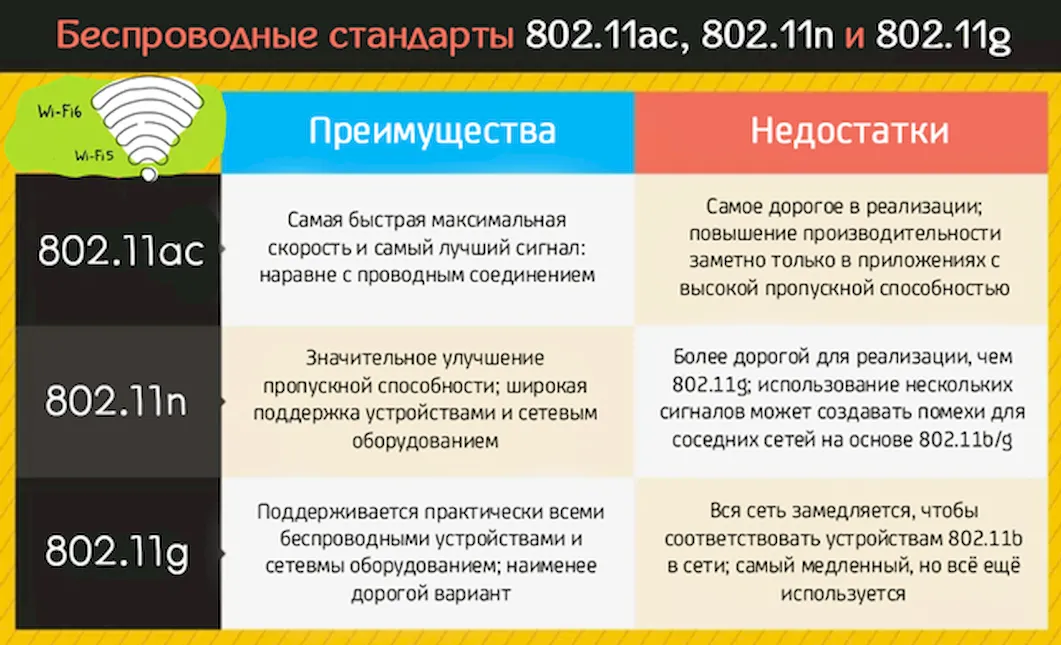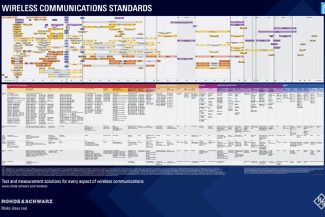The Wi-Fi Alliance is an alliance of computer manufacturers from around the world that develops and publishes standards for Wi-Fi networks. The entire technology industry follows them and develops wireless devices that are compatible with each other using Wi-Fi standards.
Introduction
Wi-Fi remains one of the most promising wireless communication technologies. It is rapidly evolving and embracing new wireless solutions to increase data speeds. Even with the development of LTE networks, Wi-Fi is not left behind, but rather gets an additional branch of development, offloading traffic in the most demanded areas of the network.
Wi-Fi for indoor applications within the limits of the statutory radiation power does not require obtaining a permit for the use of frequencies. In addition, the organization of a Wi-Fi network in a home or small office is quite simple, so you can often do it yourself. Nevertheless, when designing a network with high requirements for communication quality, coverage density and bandwidth, as a rule, resort to the help of professionals. The deployment of Wi-Fi network takes much less time compared to laying the SCS to jobs. That for the ease of setting up, deployment, relative cheapness and convenience, Wi-Fi is rightly considered one of the most promising and actively developing technologies.
Requirements for Wi-Fi equipment are described in a set of standards IEEE 802.11. With the release of each new standard to 802.11 was added a letter, such as 802.11a/b/n, etc. Today there are several dozen varieties of Wi-Fi standards. Not all standards were aimed at increasing data rates, some addressed security issues (e.g., 802.11i), others included a description of how roaming works (802.11r), etc.
The table below summarizes the Wi-Fi standards in which the data rates have been increased:
| Standard | Range | Year of issue | Approximate speed, Mbps |
| 802.11 | 2.4 GHz | 1997 | 1 |
| 802.11b | 2.4 GHz | 1999 | 5 (11) |
| 802.11a | 5 GHz | 2001 | 54 |
| 802.11g | 2.4 GHz | 2003 | 54 |
| 802.11n | 2.4 / 5 GHz | 2009 | 600 |
| 802.11ac | 5 GHz | 2014 | 7000 |
| 802.11ad | 60 GHz | 2009 | 7000 |
| 802.11ax | 2.4 / 5 GHz | 2019 | 11 000 |
| 802.11ay | 60 GHz | under development | 20 000 |
Frequency ranges of Wi-Fi networks
Most conventional client routers and consumer Wi-Fi devices operate in two frequency bands: 2.4 GHz (802.11 b/g/n) and 5 GHz (802.11 a/n/ac).
There are 14 channels defined by standards in the 2.4 GHz band. Some of them may not be available in some countries (for example, channel 14 is only allowed in Japan). Channels with numbers 1, 6 and 11 are considered to be completely non-intersecting in frequency and are called, oddly enough, "non-intersecting". But in fact, there is always an "unaccounted for" and if the access points are close enough to each other, then the non-intersecting channels become intersecting as well:
Each channel occupies a width of 20 MHz. In some cases, standards allow a channel width of 40 MHz (see Channel Aggregation section). Channel numbers and their center frequencies are shown in the figure.
Use of non-intersecting channels is convenient in the case when it is necessary to organize uniform radio coverage so that nearby equipment does not interfere with each other, thereby increasing stability and quality of communication:
One of the disadvantages of the 2.4 GHz band is its high congestion and small number of channels. Not only other Wi-Fi devices and access points, but also Bluetooth devices operating in the same frequency range can interfere with the Wi-Fi network. Even an ordinary household microwave oven can have a very large impact on the quality of the connection in the 2.4 GHz band. To minimize the mutual influence, the power of Wi-Fi transmitters is strictly limited and regulated. The use of a high-power transmitter requires a permit from the radio frequency center.
What 802.11 is.
In 1997, the Institute of Electrical and Electronics Engineers created the first WLAN standard. They called it 802.11 в after the name of the group created to oversee its development. Unfortunately, 802.11 only supported a maximum network bandwidth of 2 Mbps – too slow for most modern applications. For this reason, conventional 802.11 wireless products are no longer made. However, a whole family has grown out of that initial standard.
The best way to look at these standards is to look at 802.11 as a foundation, and all other iterations as building blocks on that foundation that aim to improve both small and large aspects of the technology. Some of the building blocks are minor and others are quite large.

Below is a brief overview of the most recent approved iterations, described from the newest to the oldest. Other iterations – 802.11ax, 802.11ay and 802.11az – are still in the approval process.
Iterations of the 802.11 standard
802.11aj.
This standard, known as the "Chinese millimeter wave," is used in China and is a rebranding of the 802.11ad standard for use in certain regions of the world. The goal is to maintain backward compatibility with 802.11ad.
802.11ah
Approved in May 2017, the standard aims for lower power consumption and creates extended-range Wi-Fi networks that can go beyond the reach of typical 2.4 GHz or 5 GHz networks. It is expected to compete with Bluetooth, given its lower power requirements.
802.11ad.
Approved in December 2012, this standard is unusually fast. However, the client device must be within 10 meters of the access point.
802.11ac
This is the generation of Wi-Fi that marked the first use of dual-band wireless technology, supporting simultaneous connections in the 2.4 GHz and 5 GHz Wi-Fi bands. The 802.11ac standard offers backward compatibility with 802.11b/g/n and up to 1,300 Mbps bandwidth on 5 GHz, up to 450 Mbps on 2.4 GHz. Most home wireless routers meet this standard.
802.11n
802.11n standard (also known as Wireless N) was designed to improve 802.11g in terms of supported bandwidth through the use of multiple wireless signals and antennas (referred to as MIMO ) instead of just one. The Industry Standards Group ratified 802.11n in 2009 with specifications providing up to 300 Mbps of network bandwidth. 802.11n also offers slightly better range than earlier Wi-Fi standards through increased signal strength and backward compatibility with 802.11b/g equipment.
802.11g
In 2002 and 2003, WLAN products supporting the new 802.11g. 802.11g attempts to combine the best of 802.11a and 802.11b. 802.11g supports bandwidths up to 54 Mbps and uses the 2.4 GHz frequency for more range. 802.11g is backward compatible with 802.11b, which means that 802.11g access points will work with 802.11b wireless adapters and vice versa.
History of
The standard has been in development since 2002. The first draft of the specification was released in 2006 and enabled companies to integrate support for the standard into notebooks, access points, routers, and other equipment. However, the draft status of the standard forced them to use the phrase "802.11 Draft-N" ("802.11n Draft"). After the official approval of the standard the prefix "Draft" is no longer required.
A total of over 400 people from semiconductor and networking companies, service providers and academic institutions in more than 20 countries were involved in the development of the standard.
What is 802.11ac, also known as Wi-Fi 5?
802.11ac or IEEE 802.11ac is a wireless networking standard that was published in late 2013. Wi-Fi 802.11ac is also known as Wi-Fi 5 . 802.11ac is the most common wireless standard today, as most routers sold in the last few years are compatible with 802.11ac. This standard, like the previous 802.11n, supports MU-MIMO , but it can offer maximum data rates of up to 2.3 Gbps. 802.11ac only works in the 5 GHz frequency band, but most wireless routers that support it also support 802.11n in the 2.4 GHz frequency band.
802.11ac devices fall into two categories, called 802.11ac Wave 1 and Wave 2. Products that are marketed as part of 802.11ac Wave 1 were introduced to the market in 2013, while Wave 2 devices were introduced in 2016. Wave 2 is an improved version of the standard. 802.11ac Wave 2 wireless routers have higher throughput and add support for MU-MIMO: while Wave 1 routers can provide speeds up to 1.3 Gbps, Wave 2 routers can provide speeds up to 2.3 Gbps. So if you're buying a wireless router today, it's recommended that you check to see if it offers 802.11ac Wave 2 support to benefit from improved speed and wireless coverage.
What is 802.11ax?
802.11ax or IEEE802.11ax is a wireless network standard that is still in development and not yet approved. It is expected to be finalized and approved sometime in late 2019, according to ZDNet: 802.11ax Next Generation Wi-Fi: Dense, Fast, Latency .
802.11ax is also referred to as Wi-Fi 6. It is also known as High-Efficiency Wireless (HEW) and is designed to operate in the same 2.4 GHz and 5 GHz frequency bands as the standards we have mentioned so far. It looks like it will also be able to work with additional frequency bands from 1 to 7 GHz when they become available. The 802.11ax wireless standard aims to quadruple the average data rate of the 802.11ac standard. It should offer significantly improved speeds, especially in crowded places such as airports, train stations, restaurants or cafes.
Wireless routers and Wi-Fi mesh systems with Wi-Fi 6 are already on the market. However, they tend to be more expensive, and most people can't afford them. Once the standard is approved and finalized, we can expect to see more affordable Wi-Fi equipment.
Crowds and neighbors are no hindrance to Wi-Fi 6
Wireless access points have one unpleasant feature: if you connect a lot of equipment to them, the speed sometimes drops a lot. This is especially critical for crowded places like airports, shopping malls, hotels, and even offices. Wi-Fi of the previous generations in such conditions works very slowly. In the case of the "six", the developers have provided a number of technologies that speed up data transfer and reception in such scenarios. For example, Intel claims at least a fourfold increase in speed in congested networks.
Wi-Fi 6 will improve connectivity in public places, apartment buildings, and networks with a large number of gadgets.
Wi-Fi 6 improves speed and signal stability by dividing the wireless channel into multiple subchannels. Any of them transmits information that is specific to a particular device. This feature is called Orthogonal Frequency Division Multiple Access (OFDMA).
Improved multi-user MU-MIMO technology allows not only to simultaneously broadcast a signal over the air, as it was implemented in Wi-Fi 5, but also to receive it. Even two sixth standard routers placed next to each other can operate on the same channel without interfering with each other. The secret is that each access point ignores the "alien" signal, favoring only its own.
What happens to Wi-Fi next?
Qualcomm said it's starting to work on the next generation of Wi-Fi. They've already introduced an official technical name for it – 802.11be. The upcoming technology will please with such innovations:
- the maximum data transfer rate will increase to 30 Gbps;
- there will be a 6 GHz band in addition to 2.4 and 5 GHz;
- The number of simultaneously connected devices with CMU-MIMO technology will increase;
- amplitude modulation will increase from 1024 to 4096 bits to improve the information content of the radio signal.
The mass introduction of Wi-Fi 7 is supposedly planned for 2024. And in the next four years or more, we will experience all the advantages of Wi-Fi 6, the adaptation of which is just beginning.
Read More:





